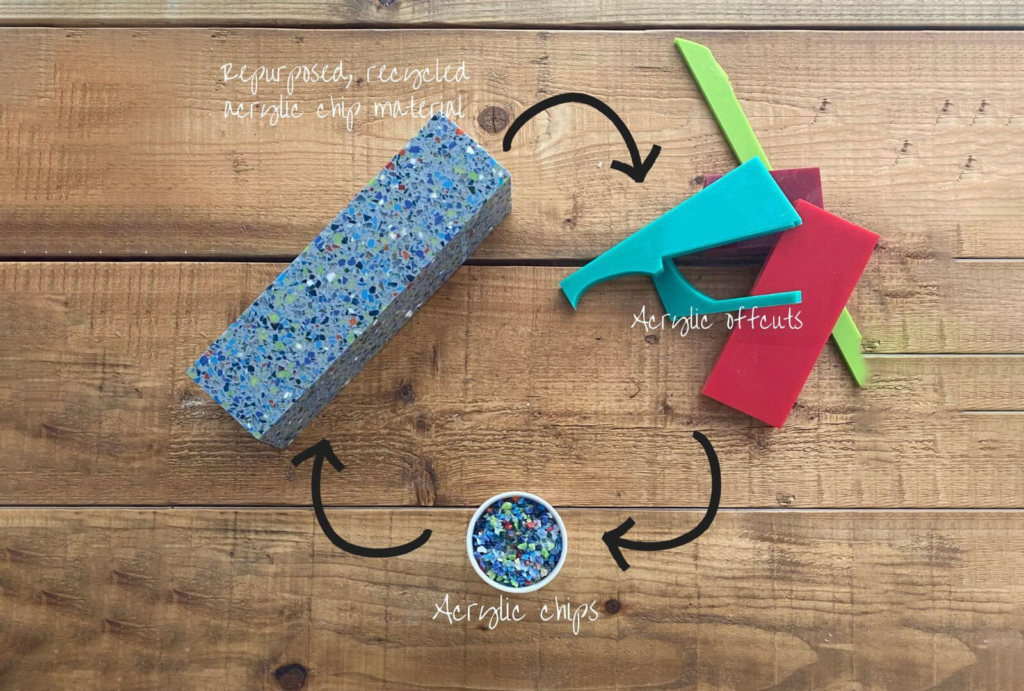Is acrylic a sustainable material?
Table of Contents
What is Sustainability?
Meeting the needs of the present without compromising the ability of future generations to meet their own needs.
The United Nations Brundtland Commission, 1987.
Sustainability strives to achieve an equilibrium between consumption and consideration. According to UCLA, the three pillars of sustainable development are economic growth, environmental protection, and social equality.
Excessive consumption by our planet leads to climate change, various forms of pollution, and a decline in the health of our ecosystems. Consequently, our current linear economy is no longer viable in creating a sustainable future. With our world’s population expected to peak at 10 billion by 2050, we must remember that the earth’s raw materials are not infinite.
Firstly, businesses must start engaging in responsible production, ensuring that products and services achieve the maximum life and value from their resources. Sustainable manufacturing is now a moral, environmental, and economic imperative.
Manufacturing and Sustainability
For manufacturing, implementing sustainable practices is an ongoing commitment, and undoubtedly presents its challenges. With over 95% of the world’s goods produced relying on the chemical industry in some way, our industry plays a vital role in investigating sustainable solutions.
To embrace sustainable development, manufacturing must remain innovative. Here at Midton, we are committed to continuous research and development, keeping up with developments in the latest technologies and products to ensure we are playing our part. This lets us environmentally grow, and also meet the market’s needs.
Part of solving this global climate emergency is seen within the Circular Economy, with the ultimate goal to design out waste. This term applies to life as well as manufacturing, with the thought that everything has value. In brief, a circular economy follows “make, use, remake”, as opposed to “make, use, dispose”.
So, is acrylic aligned with sustainable manufacturing? Can we embrace the circular economy?
Is Acrylic a Sustainable Material?
Yes – acrylic is a highly sustainable material, which comes as a surprise to many.
Versatile, durable and recyclable, acrylic is key to a range of sustainable solutions.
It is no secret that plastics have a notoriously bad reputation for their impact on the environment. However, plastics in fact have a very good environmental profile, and are an industry leader in research, development, and innovation. As a group, plastics make a huge contribution to sustainable development through the likes of recyclability and energy-saving and energy-recovering options.
Where acrylic runs into trouble is the lack of education and facilities surrounding its recycling capabilities. While most users would choose to recycle their waste, the limited availability of knowledge and ethical recycling facilities, prevents them from doing so.
Many recycling companies do not have the facilities to recycle acrylics. As a result of this, acrylic is one of the least recycled types of plastic – leading to its bad reputation.
However, acrylic is highly recyclable. Acrylic can be chipped, melted and extruded into new products. Furthermore, the plastic is infinitely recyclable, meaning it can be recycled without losing its properties.
How did Midton adapt?
At Midton, we identified the gap in recycling and knew we had to change this. We invested in a chipper for our factory to recycle and process industrial waste. This allows us to develop our innovative material, Remade. Remade is our offering of recycled acrylic – 100% PMMA, manufactured with up to 70% recycled content and 100% recyclable.
Overall, provided with the right resources and education, acrylic is a hugely sustainable material for you to use. Versatile, customisable, durable, lightweight and recyclable – acrylic is an obvious choice for many bespoke sustainability-focused projects.

Employee Recognitions in the Modern Age
Why it pays to recognise and reward your employees Here at midton, we provide countless…

One Tree Planted: Ghana and Kenya
This month, we have reached a new tree-planting milestone. Since establishing our commitment to tree…

